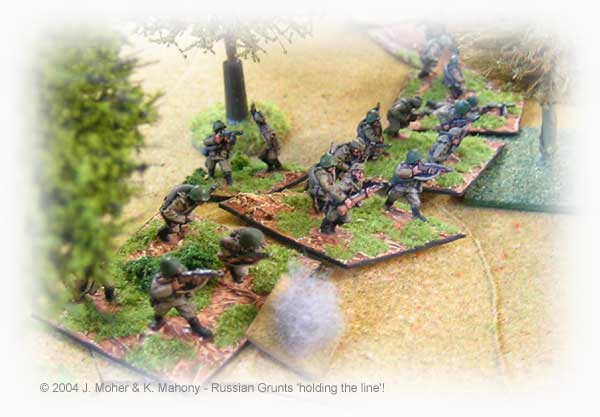Crossfire is a small-unit action game where one stand equals a squad/section, vehicles and crew-served weapons are 1:1. The emphasis is on infantry combat and AFVs are simplified to keep them from dominating the game. The basic unit is a platoon of 3-4 rifle/SMG stands, a platoon commander (PC) and possibly an attached heavy weapon (e.g. HMG). A player normally runs a company made up of 2-3 platoons along with some fire support from mortars or larger guns under the command of a company commander (CC).
The game moves along by alternating initiatives. The first player performs an action with any of his stands or groups. (Groups can be formed by whole platoons or parts of a platoon). If this action fails, initiative passes to the second player and so on. If an action succeeds, the player can continue making actions indefinitely.

Actions are basically movement, rallying, or fire. Any movement, even pivoting, can provoke reaction fire. If the reactive fire succeeds in suppressing the target stand, the move is a failure and initiative passes. If a player attempts to fire and does not achieve a suppression or better, initiative passes. If a player attempts to rally a pinned or suppressed stand and fails, initiative passes.
Movement is unmeasured, you basically move from feature to feature. Fire is also unmeasured. If you have line of sight, you can shoot (the game is assumed to take place well within effective small arms ranges). The terrain should be arranged to break up line of sight as well as preventing any kind of “hyperjump” movement. A move action is limited by being straight ahead only or a pivot. Also, a move action cannot go through a terrain feature. Thus getting from one place to another on the table may require several move actions – each move action is open to enemy reactive fire.
In sum, the game focuses on fire and movement. It’s a lot like a free-form kind of kriegspiel. You don’t lose yourself in the mechanics and you’re free to concentrate on the tactical problem. The above outline, lengthy as it is, is just a brief sketch. There are certainly some fine points to the game.
My appreciation of the game is that it’s very fluid and moves along quickly. It was designed to be a two-player game, but we’ve been playing it here as a multi-player game without any problems (in fact, I’ve never done a 1 on 1 game with it). I recommend it highly.
David Sullivan